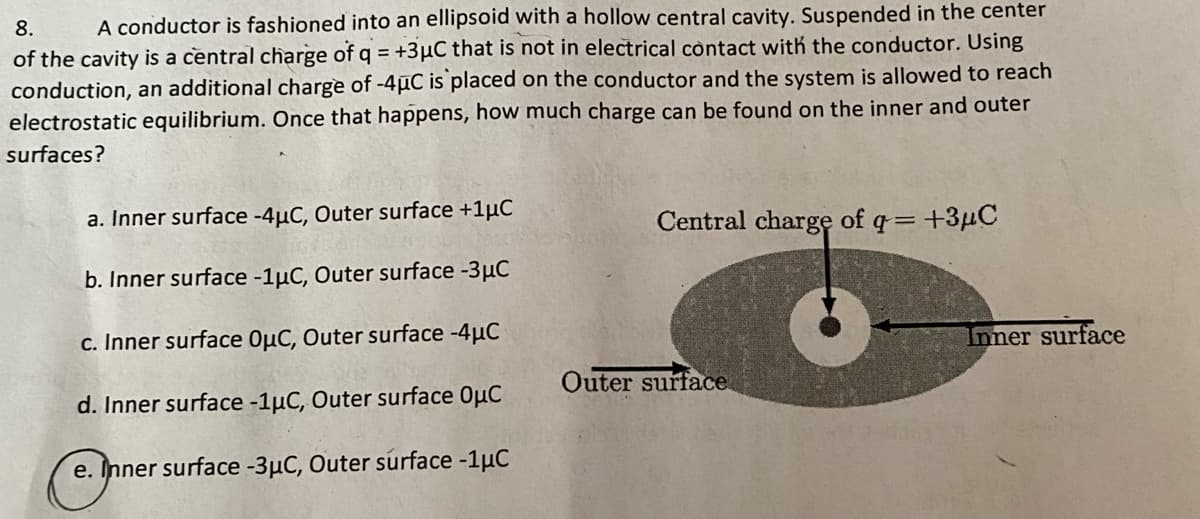A conductor is fashioned into an ellipsoid with a hollow central cavity. Suspended in the center of the cavity is a central charge of q = +3µC that is not in electrical còntact with the conductor. Using conduction, an additional charge of -4µC is placed on the conductor and the system is allowed to reach electrostatic equilibrium. Once that happens, how much charge can be found on the inner and outer 8. surfaces? a. Inner surface -4µC, Outer surface +1µC Central charge of q=+3µC b. Inner surface -1µC, Outer surface -3µC c. Inner surface OuC, Outer surface -4µC Inner surface Outer surface d. Inner surface -1µC, Outer surface OµC e. Inner surface -3µC, Outer surface -1µC
A conductor is fashioned into an ellipsoid with a hollow central cavity. Suspended in the center of the cavity is a central charge of q = +3µC that is not in electrical còntact with the conductor. Using conduction, an additional charge of -4µC is placed on the conductor and the system is allowed to reach electrostatic equilibrium. Once that happens, how much charge can be found on the inner and outer 8. surfaces? a. Inner surface -4µC, Outer surface +1µC Central charge of q=+3µC b. Inner surface -1µC, Outer surface -3µC c. Inner surface OuC, Outer surface -4µC Inner surface Outer surface d. Inner surface -1µC, Outer surface OµC e. Inner surface -3µC, Outer surface -1µC
Physics for Scientists and Engineers: Foundations and Connections
1st Edition
ISBN:9781133939146
Author:Katz, Debora M.
Publisher:Katz, Debora M.
Chapter25: Gauss’s Law
Section: Chapter Questions
Problem 58PQ: A charged rod is placed in the center along the axis of a neutral metal cylinder (Fig. P25.57). The...
Related questions
Question
Not exactly sure but if I am doing right steps help me out to clarify

Transcribed Image Text:A conductor is fashioned into an ellipsoid with a hollow central cavity. Suspended in the center
of the cavity is a central charge of q = +3µC that is not in electrical còntact with the conductor. Using
conduction, an additional charge of -4µC is placed on the conductor and the system is allowed to reach
electrostatic equilibrium. Once that happens, how much charge can be found on the inner and outer
8.
surfaces?
a. Inner surface -4µC, Outer surface +1µC
Central charge of q= +3µC
b. Inner surface -1µC, Outer surface -3µC
c. Inner surface OµC, Outer surface -4µC
Inner surface
Outer suřface
d. Inner surface -1µC, Outer surface OµC
e. Înner surface -3µC, Outer surface -1µC
Expert Solution
This question has been solved!
Explore an expertly crafted, step-by-step solution for a thorough understanding of key concepts.
Step by step
Solved in 2 steps with 2 images

Knowledge Booster
Learn more about
Need a deep-dive on the concept behind this application? Look no further. Learn more about this topic, physics and related others by exploring similar questions and additional content below.Recommended textbooks for you

Physics for Scientists and Engineers: Foundations…
Physics
ISBN:
9781133939146
Author:
Katz, Debora M.
Publisher:
Cengage Learning

Principles of Physics: A Calculus-Based Text
Physics
ISBN:
9781133104261
Author:
Raymond A. Serway, John W. Jewett
Publisher:
Cengage Learning

Physics for Scientists and Engineers, Technology …
Physics
ISBN:
9781305116399
Author:
Raymond A. Serway, John W. Jewett
Publisher:
Cengage Learning

Physics for Scientists and Engineers: Foundations…
Physics
ISBN:
9781133939146
Author:
Katz, Debora M.
Publisher:
Cengage Learning

Principles of Physics: A Calculus-Based Text
Physics
ISBN:
9781133104261
Author:
Raymond A. Serway, John W. Jewett
Publisher:
Cengage Learning

Physics for Scientists and Engineers, Technology …
Physics
ISBN:
9781305116399
Author:
Raymond A. Serway, John W. Jewett
Publisher:
Cengage Learning

College Physics
Physics
ISBN:
9781938168000
Author:
Paul Peter Urone, Roger Hinrichs
Publisher:
OpenStax College


College Physics
Physics
ISBN:
9781305952300
Author:
Raymond A. Serway, Chris Vuille
Publisher:
Cengage Learning